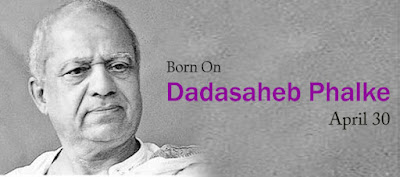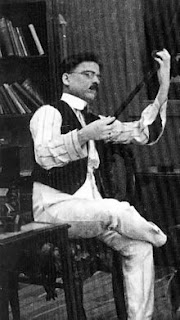Wikipedia Dadasaheb Phalke - WikiEvents
Wikipedia Dadasaheb Phalke
From WikiEvents, the free encyclopedia
Wikipedia Dadasaheb Phalke
 Dhundiraj Govind Phalke (Marathi: धुंडीराज गोविंद फाळके), prevalently known as Dadasaheb Phalke (Marathi: दादासाहेब फाळके) (About this sound elocution (30 April 1870 – 16 February 1944), was an Indian maker executive screenwriter, known as the Father of Indian film. Beginning with his introduction film, Raja Harishchandra the main Marathi silver screen which was additionally the primary Indian silver screen in 1913, now known as India's first full-length highlight, he made 95 motion pictures and 27 short movies in his profession spreading over 19 years, till 1937, including his most noted works: Mohini Bhasmasur (1913), Satyavan Savitri (1914), Lanka Dahan (1917), Shri Krishna Janma (1918) and Kaliya Mardan (1919).
Dhundiraj Govind Phalke (Marathi: धुंडीराज गोविंद फाळके), prevalently known as Dadasaheb Phalke (Marathi: दादासाहेब फाळके) (About this sound elocution (30 April 1870 – 16 February 1944), was an Indian maker executive screenwriter, known as the Father of Indian film. Beginning with his introduction film, Raja Harishchandra the main Marathi silver screen which was additionally the primary Indian silver screen in 1913, now known as India's first full-length highlight, he made 95 motion pictures and 27 short movies in his profession spreading over 19 years, till 1937, including his most noted works: Mohini Bhasmasur (1913), Satyavan Savitri (1914), Lanka Dahan (1917), Shri Krishna Janma (1918) and Kaliya Mardan (1919). Wikipedia Dadasaheb Phalke
The Dadasaheb Phalke Honor, for lifetime commitment to film, was initiated in his respect by the Legislature of India in 1969. The honor is a standout amongst the most esteemed honors in Indian silver screen and is the most noteworthy authority acknowledgment for film identities in the nation. A postage stamp bearing his resemblance was discharged by India Post to respect him in 1971. A privileged honor from the Dadasaheb Phalke Institute Mumbai was presented in the year 2001, for lifetime accomplishment in Indian silver screen.
Biography
Early life and education
Dhundiraj Govind Phalke was conceived in a Marathi speaking Deshastha Brahmin family on 30 April 1870 at Tryambakeshwar, 30 km from Nashik, Maharashtra, India, where his dad was a refined researcher. He joined Sir J. J. School of Craftsmanship, Mumbai in 1885. Subsequent to going from J.J. School in 1890, Dadasaheb Phalke went to the Kala Bhavan, Maharaja Sayajirao College of Baroda in Vadodara, where he examined mold, building, drawing, painting and photography.
Wikipedia Dadasaheb Phalke
Early career
He started his vocation as a residential area picture taker in Godhra, yet needed to leave business after the demise of his first spouse and youngster in a flare-up of the bubonic torment. He soon met the German mystical performer Carl Hertz, one of the 40 conjurers utilized by the Lumiere Siblings. Before long, he had the chance to work with the Archeological Overview of India as an artist. In any case, anxious with his activity and its imperatives, he swung to the matter of printing. He spent significant time in lithography and oleograph, and worked for painter Raja Ravi Varma. Dadasaheb Phalke later began his own particular printing press, made his first outing abroad to Germany, to find out about the most recent innovation, apparatus and for workmanship moreover.
Wikipedia Dadasaheb Phalke
Film
 |
| Dadasaheb Phalke seated on a chair with a small roll of film in his hands |
Following a question with his accomplices about the running of the press, he surrendered printing and turned his consideration regarding moving pictures, in the wake of viewing a noiseless film, The Life of Christ and imagining Indian divine beings on the screen. Dadasaheb Phalke made his first film, Raja Harishchandra, in 1912; it was first indicated freely on 3 May 1913 at Mumbai's Crowning ordinance Silver screen, adequately denoting the start of the Indian film industry. Around one year prior, Ramchandra Gopal (known as Dadasaheb Torne) had recorded in front of an audience a film dramatization called Pundalik and had demonstrated the account at a similar theater. Nonetheless, the credit for influencing the main indigenous Indian to highlight film is ascribed to Dadasaheb Dadasaheb Phalke as it is said that "Pundalik" had English cinematographers.
Wikipedia Dadasaheb Phalke
By and by, Dadasaheb Phalke demonstrated effective in his new workmanship and continued to make a few quiet movies, shorts, narrative component, instructive and comic, tapping all the capability of this new medium. Film, having demonstrated its monetary feasibility, soon pulled in agents who favored cash over style. Wikipedia Dadasaheb Phalke
Hindustan films
 |
| Raja Harischandra 1913, directed by Dadasaheb Phalke |
Dadasaheb Phalke shaped a film organization, Hindustan Movies in association with five specialists from Mumbai, with the expectation that by having the monetary part of his calling dealt with by specialists in the field, he would be allowed to seek after the innovative viewpoint. He set up a model studio and prepared experts and performing artists at the same time, soon, he kept running into difficult issues with his accomplices. In 1920, Dadasaheb Phalke surrendered from Hindustan Movies, made his first declaration of retirement from silver screen, and he composed Rangbhoomi, an acclaimed play. Without his to a great degree innovative virtuoso, Hindustan Movies kept running into profound budgetary misfortunes, and he was at last convinced to return. Be that as it may, Dadasaheb Phalke felt compelled by the business and, subsequent to coordinating a couple of movies for the organization, he pulled back from it.
Wikipedia Dadasaheb Phalke
Sound film
The circumstances changed and Dadasaheb Phalke succumbed to the rising innovation of sound film. Unfit to adapt to the talkies, the man who had fathered the Indian film industry ended up out of date. His last noiseless film Setubandhan was discharged in 1932 and later discharged with naming. Amid 1936– 38, he created his last film Gangavataran (1937), preceding resigning to Nashik, where he passed on 16 February 1944.
Wikipedia Dadasaheb Phalke
Selected filmography
 |
| Picture of Dadasaheb Phalke |
- Raja Harishchandra (1913)
- Mohini Bhasmasur (1913)
- Satyavan Savitri (1914)
- Lanka Dahan (1917)
- Shri Krishna Janma (1918)
- Kaliya Mardan (1919)
- Buddhadev (1923)
- Setu Bandhan (1932)
- Gangavataran (1937)
In popular culture
In 2009, the Marathi movie Harishchandrachi Industrial facility, which was coordinated by theater veteran Paresh Mokashi and delineates Dadasaheb Phalke's battle in making Raja Harishchandra in 1913, was chosen as India's legitimate section to the Institute Honors in the Best Outside Dialect Film class.
Wikipedia Dadasaheb Phalke

Comments
Post a Comment